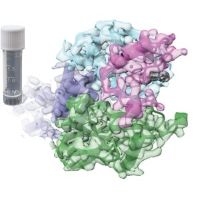Specification
| Description | Recombinant protein from the full-length sequence of homo sapiens arginine demethylase and lysine hydroxylase (JMJD6), transcript variant 2 (NM_015167). |
| Organism | Homo sapiens (Human) |
| Expression Host | Human Cells |
| Tag Info | His or DYKDDDDK. Please contact us if you need further information or require specific designed tag. |
| Purity | Greater than 90% by SDS-PAGE gel |
| Uniprot ID | Q6NYC1 |
| Entry Name | JMJD6_HUMAN |
| Gene Names | JMJD6 KIAA0585 PSR PTDSR |
| Alternative Gene Names | KIAA0585 PSR PTDSR |
| Alternative Protein Names | Bifunctional arginine demethylase and lysyl-hydroxylase JMJD6 (EC 1.14.11.-) (Histone arginine demethylase JMJD6) (JmjC domain-containing protein 6) (Jumonji domain-containing protein 6) (Lysyl-hydroxylase JMJD6) (Peptide-lysine 5-dioxygenase JMJD6) (Phosphatidylserine receptor) (Protein PTDSR) |
| Application | Antigens, Western, ELISA and other in vitro binding or in vivo functional assays, and protein-protein interaction studies; For research & development use only! |
| Buffer | Purified protein formulated in a sterile solution of PBS buffer, pH7.2, without any preservatives |
| Endotoxin | Endotoxin level is < 0.1 ng/µg of protein (<1EU /µg) |
| Length | 403 |
| Molecular Weight(Da) | 46462 |
| Protein Sequence | (The sequence of expressed protein may have some variation from the sequence shown below. Please contact us for the exact sequence.) MNHKSKKRIREAKRSARPELKDSLDWTRHNYYESFSLSPAAVADNVERADALQLSVEEFVERYERPYKPVVLLNAQEGWSAQEKWTLERLKRKYRNQKFKCGEDNDGYSVKMKMKYYIEYMESTRDDSPLYIFDSSYGEHPKRRKLLEDYKVPKFFTDDLFQYAGEKRRPPYRWFVMGPPRSGTGIHIDPLGTSAWNALVQGHKRWCLFPTSTPRELIKVTRDEGGNQQDEAITWFNVIYPRTQLPTWPPEFKPLEILQKPGETVFVPGGWWHVVLNLDTTIAITQNFASSTNFPVVWHKTVRGRPKLSRKWYRILKQEHPELAVLADSVDLQESTGIASDSSSDSSSSSSSSSSDSDSECESGSEGDGTVHRRKKRRTCSMVGNGDTTSQDDCVSKERSSSR |
Background
| Function | FUNCTION: Dioxygenase that can both act as a arginine demethylase and a lysyl-hydroxylase (PubMed:24498420, PubMed:17947579, PubMed:20684070, PubMed:21060799, PubMed:22189873). Acts as a lysyl-hydroxylase that catalyzes 5-hydroxylation on specific lysine residues of target proteins such as U2AF2/U2AF65 and LUC7L2. Regulates RNA splicing by mediating 5-hydroxylation of U2AF2/U2AF65, affecting the pre-mRNA splicing activity of U2AF2/U2AF65 (PubMed:19574390). Hydroxylates its own N-terminus, which is required for homooligomerization (PubMed:22189873). In addition to peptidyl-lysine 5-dioxygenase activity, may act as an RNA hydroxylase, as suggested by its ability to bind single strand RNA (PubMed:20679243, PubMed:29176719). Also acts as an arginine demethylase which preferentially demethylates asymmetric dimethylation (PubMed:17947579, PubMed:24498420, PubMed:24360279). Demethylates histone H3 at 'Arg-2' (H3R2me) and histone H4 at 'Arg-3' (H4R3me), including mono-, symmetric di- and asymmetric dimethylated forms, thereby playing a role in histone code (PubMed:17947579, PubMed:24360279). However, histone arginine demethylation may not constitute the primary activity in vivo (PubMed:17947579, PubMed:21060799, PubMed:22189873). In collaboration with BRD4, interacts with the positive transcription elongation factor b (P-TEFb) complex in its active form to regulate polymerase II promoter-proximal pause release for transcriptional activation of a large cohort of genes. On distal enhancers, so called anti-pause enhancers, demethylates both histone H4R3me2 and the methyl cap of 7SKsnRNA leading to the dismissal of the 7SKsnRNA:HEXIM1 inhibitor complex. After removal of repressive marks, the complex BRD4:JMJD6 attract and retain the P-TEFb complex on chromatin, leading to its activation, promoter-proximal polymerase II pause release, and transcriptional activation (PubMed:24360279). Demethylates other arginine methylated-proteins such as ESR1 (PubMed:24498420). Has no histone lysine demethylase activity (PubMed:21060799). Required for differentiation of multiple organs during embryogenesis. Acts as a key regulator of hematopoietic differentiation: required for angiogenic sprouting by regulating the pre-mRNA splicing activity of U2AF2/U2AF65 (By similarity). Seems to be necessary for the regulation of macrophage cytokine responses (PubMed:15622002). {ECO:0000250|UniProtKB:Q9ERI5, ECO:0000269|PubMed:15622002, ECO:0000269|PubMed:17947579, ECO:0000269|PubMed:19574390, ECO:0000269|PubMed:20679243, ECO:0000269|PubMed:20684070, ECO:0000269|PubMed:21060799, ECO:0000269|PubMed:22189873, ECO:0000269|PubMed:24360279, ECO:0000269|PubMed:24498420, ECO:0000269|PubMed:29176719}. |
| Pathway | |
| Protein Families | JMJD6 family |
| Tissue Specificity | Highly expressed in the heart, skeletal muscle and kidney. Expressed at moderate or low level in brain, placenta, lung, liver, pancreas, spleen, thymus, prostate, testis and ovary. Up-regulated in many patients with chronic pancreatitis. Expressed in nursing thymic epithelial cells. {ECO:0000269|PubMed:15072554, ECO:0000269|PubMed:15622002, ECO:0000269|PubMed:9628581}. |
QC Data
| Note | Please contact us for QC Data |
| Product Image (Reference Only) |  |

